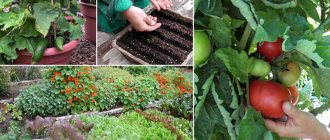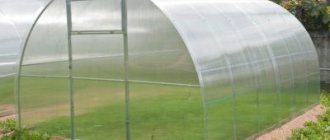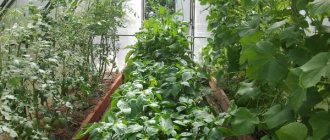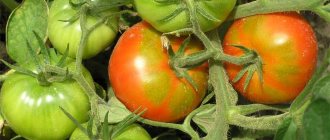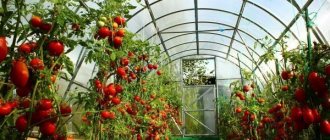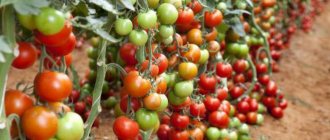In Russia, they love tomatoes so much that they are grown even in northern regions with very short summers and in “risky farming” zones, where conditions seem to be completely unsuitable for a heat-loving crop. In fact, thanks to breeding work, cold- and drought-resistant varieties of tomatoes have long been developed. Where the climate allows, plants are planted in open ground, where it is more difficult to get full returns from them - in specially equipped greenhouses and even in city apartments on the windowsill. But if space in the garden is limited, then you inevitably have to think about which vegetables are best to plant after tomatoes.
The fruits have a variety of shapes, sizes, colors and, naturally, differ in taste and ripening time
In this section of the site you will find information about popular varieties and hybrids recommended for cultivation in different regions in open and protected ground conditions.
Each variety or hybrid is good and interesting in its own way, but it is impossible to cultivate them constantly in the same place. When choosing crops that are more rational to plant after tomatoes next year, you need to be guided by the principles of crop rotation, which are developed taking into account the botanical characteristics and needs of plants. These rules will also make it possible to combine the cultivation of certain vegetables during compaction planting, so that the usable area is not wasted.
What soil and growing conditions do tomatoes need?
Lighting
Tomatoes are a heat-loving and light-loving vegetable crop.
During the period of fruit ripening, the plant requires bright, intense lighting, otherwise the fruits will be less tasty.
- The seeds of this vegetable plant can germinate at a temperature of at least +14°C, but at higher temperatures (within 20-22°C) sprouts appear faster.
- And the growth of adult plants begins to slow down at temperatures below +12°C; shoots stop growing completely when the thermometer drops below +9°C.
If plants do not have enough lighting, they begin to stretch out and weaken. As a result, flowering and fruiting of these plants will be delayed. Lack of lighting is especially dangerous when growing seedlings at home.
Air humidity
The next requirement is optimal air and soil humidity.
The level of air humidity should not exceed 60%, and soil - 70-75%.
Increased air or soil humidity can lead to the development of various fungal diseases, root rot, and blackleg. Some of these diseases cannot be cured, so the plants have to be destroyed.
Fertilizer
Tomatoes also require nutrients; plants can only obtain them from the soil. Therefore, the beds in which tomatoes will grow must be pre-fertilized.
- In the fall, when digging, organic matter (compost, humus, manure) is added to the soil at the rate of 10 kg per square.
- In the spring, when digging again, complex mineral fertilizers are added to the soil, and then beds are formed in which tomato seedlings will be planted.
During the growth of seedlings, normal development of the root system requires a large amount of phosphorus, which is part of the nutrient substrate.
And then the seedlings are fed with a solution of complex mineral fertilizers twice before they are transplanted into open ground.
After transplanting the seedlings into the beds during the flowering period and the formation of ovaries, the growing bushes require potassium and phosphorus.
These minerals contribute to:
- active flowering;
- the appearance of a large number of ovaries;
- strengthening immunity.
As a result, tomato bushes develop faster, a larger number of ovaries are formed, and the plants themselves practically do not get sick, which also has a positive effect on the yield of this vegetable crop.
Effect of nitrogen on tomatoes:
- This macronutrient has a beneficial effect on any cultivated plants.
- Activates the growth of vegetative mass and root system.
But it must be introduced into the soil with caution. An excess of nitrogen leads to increased development of green mass to the detriment of flowering and fruiting, and a deficiency leads to slower growth, lightening of the foliage, and the fruits will be too small.
Priming
The best types of soil for this vegetable crop are sandy and loamy with a neutral or slightly acidic reaction.
Under such conditions, the first fruits on tomato bushes can ripen 1-1.5 months after the flowers appear.
Preparing the soil for future plantings
Tomatoes are often affected by diseases both in open ground and in greenhouses. Especially often, like all nightshades, they suffer from late blight, the causative agents of which are pathogenic pseudofungi oomycetes.
Even timely treatments do not guarantee complete protection against late blight. The peak of its activity usually occurs in July - August and coincides with the fruiting period
In this regard, systemic soil disinfection is one of the most important and mandatory procedures at the end of each gardening season. The place where tomatoes are grown must be cleaned as much as possible by available methods from accumulated pathogenic spores and harmful organisms.
After harvesting, the first thing you should do is collect all the tomato tops and burn them , even if there are no visible signs of disease on them. The resulting ash will serve as a good fertilizer.
For preventive treatments, agents are used that improve biological activity in the soil. Buy drugs that contain Bacillus subtilis, Pseudomonas or the most beneficial soil fungus Trichoderma. By the way, tank mixtures of such drugs usually work better than separately. The effect of specialized products will be more noticeable if you strictly follow the instructions for their use. Soil bacteria bring positive results only at positive temperatures.
It is advisable to sow cleared beds in the fall with green manure, for example, white mustard or rye. In the spring, 2-3 weeks before the planned planting, the ground needs to be dug up, planting young shoots of green manure grasses in it.
If plants are damaged by dangerous pests, such as spider mites, it is better not to experiment with folk remedies - you will only waste precious time
In cases where spider mites and other dangerous pests appear, begin the fight without delay from the moment they are detected, before the colony of garden aggressors has time to multiply to alarming proportions. Immediately treat the bushes with industrial chemical compounds with acaricidal and insecticidal action. For complete disinfection of greenhouse structures and related equipment (pegs, trellis nets, tools), smoke bombs are allowed to be used.
A deficiency of micro- and macroelements necessary for normal life and fruiting of any crop inevitably leads subsequently to meager harvests. In greenhouses, the soil is exploited much more intensively than in open ground, so a method such as periodic replacement of the surface layer of soil . The degree of soil fertility and plant health largely depend on the fertilizers applied. After tomatoes, it is recommended to enrich the soil with phosphorus-potassium complexes (at the rate of 30-40 g per 1 m2); it is not necessary to use organic matter if it was added for planting last fall or spring of this year.
Is it possible to plant tomatoes after tomatoes?
According to the rules of crop rotation, tomatoes can be planted in one place only for one season, and then take a break for 3-4 seasons.
If the garden or greenhouse is small, and you have to grow this crop in one place constantly, then after harvesting and destroying the tops, you need to disinfect the soil.
Or remove the top layer of soil by 5 cm. If the tomatoes are sick, then remove the soil to a thickness of up to 10 cm, then spill the soil with a solution of copper sulfate or Bordeaux mixture. Instead of the removed soil, a nutrient substrate is poured, consisting of a mixture of turf (or leaf soil), sand and humus in a 1:1:1 ratio.
Important! When tomatoes are constantly grown in one place, the soil in this area becomes too acidic, so during autumn digging, lime or chalk is added to the soil.
Why do crop rotation?
Crop rotation is the rules for changing crops during cultivation. For their development, plants gradually take certain minerals from the soil, their roots secrete microtoxins, and bacteria that cause diseases accumulate in the soil. To improve the health of the soil and make it easier to cope with diseases and pests, it is recommended to change where crops are planted. It is important to understand the basic principles of crop rotation.
Crop rotation rules:
- Avoid sequential planting of related crops in one place.
- Alternate plants with different root systems. For example, after plants with above-ground fruits, plant root crops and vice versa, replacing “tops and roots.”
- Plants with high nutrient intake should be grown after plants with medium or low nutrient intake.
- Periodically heal the soil by planting crops with natural disinfectant properties - mustard, onions, garlic.
What to plant after tomatoes next year
Tomato is the best predecessor for the following vegetable crops:
- radish;
- beets;
- carrots;
- cabbage;
- Luke;
- garlic;
- beans;
- peas;
- beans;
- soy;
- dill;
- parsley;
- salad;
- celery;
- cucumbers;
- squash;
- zucchini.
In the open ground
Since tomatoes, during the process of growth and fruiting, take almost all the nitrogen from the soil, it is therefore better to plant legumes and those types of greens after them, which, along with legumes, during the growth process enrich the soil with easily digestible nitrogen and at the same time enrich it with organic substances.
Important! During the growth process, almost all root vegetables absorb nutrients from deeper layers of soil than tomatoes, so they can also be grown after tomatoes.
Onions and garlic, as they grow, disinfect the soil, destroying pathogenic microorganisms, and their yield will be high.
Any of the representatives of pumpkin crops can be planted after tomatoes, you just need to apply restorative fertilizers.
In the greenhouse
The following vegetables and root crops can be planted indoors:
- all varieties of cabbage;
- radish;
- cucumbers;
- zucchini;
- greenery;
- spices.
All varieties of cabbage are indifferent to the lack of nitrogen in the soil and are not susceptible to the diseases that affect vegetables from the nightshade family. And before planting vegetable plants from the pumpkin family, it is necessary to add organic fertilizers to the soil.
Greens and all types of herbs grow well after tomatoes, and also help disinfect the soil.
Also, to disinfect the soil after tomatoes, you can plant any green manure.
Is it possible to plant peppers, onions, garlic, beets, carrots?
After tomatoes, you should not plant other vegetables from the nightshade family, as they can be affected by the same diseases, and they are also damaged by the same insect pests, so it is strictly forbidden to plant bell peppers after tomatoes.
Onions and garlic after tomatoes destroy pathogenic microorganisms that could remain in the soil and produce good harvests. And carrots, as a root crop, take nutrients from the soil deeper than a tomato, and therefore also produce a good harvest.
Features of growing tomatoes that affect the soil
Tomatoes are demanding on the content of nitrogen, potassium, phosphorus and calcium in the soil. Therefore, after them it is better to plant plants that restore these substances.
You can get a good harvest of tomatoes on almost any soil, but the best option for them is sandy and loamy soils. For tomatoes, the moisture permeability of the soil, its lightness and enrichment with organic fertilizers are important.
For sandy and clayey areas, additional humus and compost will be required. And on heavy carbonate soils, 30 cm of the top layer needs to be replaced. Soil acidity should be in the range of 6-6.8.
Vegetable crop rotation table
| Can be planted | Neutral | Can't plant | |
| Potato | Legumes, pumpkins, cabbage | Any root vegetables, onions, garlic | Vegetables from the nightshade family |
| Tomatoes | Pumpkin, legumes, onions, garlic, carrots, all types of cabbage, greens | Beetroot | Potatoes, peppers, eggplants |
| Eggplant, pepper | Cucumbers, zucchini, cabbage, onions, garlic, melons, beans, carrots, greens | Beetroot | Potatoes, tomatoes, pumpkin |
| Onion garlic | Potatoes, legumes, pumpkin crops, all types of cabbage | Beetroot, tomatoes | Pepper, onion, garlic, physalis, greens, carrots |
| Pumpkin crops | Legumes, potatoes, all types of cabbage, tomatoes, onions, corn | Beetroot, greens | Pumpkin crops |
| Legumes | Pumpkins, strawberries, potatoes, all types of cabbage, onions | Beets, tomatoes, greens, carrots, vegetables from the nightshade family | Corn, legumes |
| Carrot | Onions, pumpkins, all types of cabbage, potatoes, greens | Tomatoes, onions, garlic, peppers, eggplants | Carrots, beets |
| Beet | Potatoes, pumpkins, greens | Legumes, tomatoes, onions, garlic, peppers, eggplants, corn | All types of cabbage |
| Cabbage | Onions, garlic, legumes, potatoes, cucumbers, zucchini, pumpkins | Tomatoes, carrots, peppers, eggplants, corn, greens | Cabbage, radishes |
| Greenery | Pumpkins, onions, garlic, legumes | Tomatoes, eggplants, peppers, beets, potatoes, corn | Cabbage, carrots |
Then plant tomatoes
The best predecessors for tomatoes are the following vegetable crops:
- legumes;
- bulbous;
- greenery;
- carrot;
- radish;
- turnip;
- all types of cabbage;
- beet;
- pumpkin crops (for which organic fertilizers were applied);
- winter wheat;
- mustard;
- alfalfa;
- soybeans
In the open ground
If possible, in garden beds you should adhere to the basic rules of crop rotation.
Tomatoes are usually planted after:
- green manure;
- all vegetables from the cruciferous family;
- pumpkin and legume crops;
- any root vegetables;
- bulbous;
- greenery
In the greenhouse
Tomatoes can be planted indoors after the following vegetable crops:
- cucumbers;
- zucchini;
- all types of cabbage;
- radish;
- green manure;
- green crops;
- spicy herbs.
Tomatoes can be planted in the same place if the soil is disinfected during the break between plantings.
Is it possible to plant tomatoes after peppers, onions, garlic, potatoes, eggplants?
You cannot plant tomatoes after bell peppers, potatoes and eggplants, since all these vegetables belong to the nightshade family and can be affected by certain types of diseases, as well as insect pests.
And onions and garlic are the best precursors for tomatoes, as they help destroy pathogenic microorganisms and pests in the soil.
Companions and “good neighbors” when grown together
Although tomatoes do not require constant hilling and loosening between rows like potatoes, they will not respond well to compacted plantings. Bushes should be well ventilated and illuminated. But experienced gardeners have noticed that low-growing basil, savory, marjoram, rosemary, and thyme help improve the taste characteristics of ripening fruits. Joint cultivation with aromatic herbs has the most beneficial effect on vegetables.
They combine wonderfully and complement each other favorably not only in the garden, but also in dishes on the table.
Did you know that the alkaloid compound solanine, found in all above-ground parts of tomatoes, is poisonous and repels many insect pests? A concentrated infusion of tomato tops is successfully used to spray fruit plants against aphids, caterpillars, slugs and other uninvited guests.
Are cucumbers planted after tomatoes?
Any varieties of cucumbers can be planted after tomatoes, since this vegetable crop is not susceptible to late blight and is not demanding on soil quality. But before planting cucumbers in the beds, any organic fertilizers (compost, humus, rotted manure) should be added to the soil.
Can you plant cucumbers in the greenhouse after tomatoes?
In closed ground, cucumbers are planted after tomatoes only after adding a complex of mineral fertilizers and organic matter to the soil.
When is it time to change where to plant tomatoes?
Solanaceae require loamy, easily warmed soil, loose, without a certain level of acidity. Gardeners consider transplanting tomatoes to a new location annually as an ideal option. Some plot owners are forced to resort to small tricks in order to get a sufficient harvest when planting tomatoes in the same bed for several seasons in a row:
- replace the top layers of soil - they are sent to a place reserved for growing radishes, which grow best after tomatoes;
- apply certain nitrogen fertilizers - in accordance with the scheme indicated on the package;
- legumes and fragrant herbs are planted next to the tomatoes - this condition allows for partial restoration of the soil and prevents its massive depletion;
- plant the crop according to the Kizima method - with the formation of a deep root system, in plastic film;
- After removing the tomato bushes, bean and mustard varieties are planted in the fall.
What not to plant after tomatoes
Tomatoes are bad predecessors for the following vegetable and garden crops:
- potatoes;
- physalis;
- all varieties of pepper;
- tobacco;
- eggplant;
- strawberries;
- strawberries
All of these crops are susceptible to the same diseases as tomatoes, and they can also be damaged by the same insect pests. therefore, all of the above plants may suffer from:
- late blight;
- rot;
- wireworm;
- Colorado potato beetle.
And even complete disinfection of the soil does not provide a 100% guarantee of the destruction of pathogenic microorganisms and pest larvae. Therefore, in the future, plants may be affected by these diseases.
The best neighbors, what is better to plant next to tomatoes?
The best neighbors for tomatoes will be the following cultivated plants:
- corn;
- carrot;
- horseradish;
- radish;
- legumes;
- salad;
- onion;
- garlic;
- beet;
- garlic;
- spinach;
- cabbage;
- celery;
- radish;
- asparagus;
- parsley;
- basil;
- nasturtium;
- marigold;
- tansy;
- tagetis;
- coriander;
- calendula.
Marigolds, tagetis, tansy, nasturtium, coriander and marigolds repel most “harmful” bugs from tomatoes with their aroma.
Legumes and corn plantings save tomato bushes from strong wind gusts.
Basil planted nearby gives ripe tomatoes a unique aroma.
Onions and garlic planted next to tomatoes, which produce phytoncides, protect this crop from late blight. Onions repel aphids and flea beetles, and garlic protects against spider mites.
Tomatoes have a positive effect on the development of onions, garlic, legumes, all varieties of cabbage, prevent the appearance of scab on apple and pear trees, and can repel the codling moth.
Companion plants for tomatoes
Arranging plants on the site so that their proximity brings only benefits is probably the most difficult task. Tomatoes have their own recommendations and tips:
- Corn or legumes planted nearby will protect tomatoes from the wind.
- Vegetables you can plant are beets, radishes, carrots, celery and asparagus.
- Some flowers are a useful companion for tomatoes against pests - tansy, nasturtium, marigold, calendula and coriander.
- Lettuce and parsley are good companion greens. Basil will have a positive effect on the taste of the fruit, and garlic and onions will protect against late blight and various pests.
- Tomatoes can help gooseberries because they repel the moth.
- Any green manure will also work.
Useful table: which crops can be planted nearby and which ones should not be planted.


